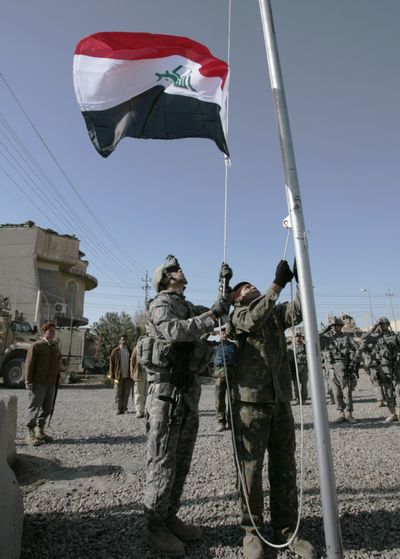Green Zone handed over
Iraqis take control of center of power in nation’s capital

BAGHDAD – The walls of the majestic Republican Palace in Baghdad’s Green Zone have been stripped bare. The vaults that secured American cash and classified documents are gone, and the cement blast walls that protected the front entrance were taken down this week. The U.S. military dining facility inside what was once the American Embassy served its last meal New Year’s Eve.
“This is the end of the world as we know it,” said Sgt. 1st Class Patrick McDonald, 47, who co-authored a guide to historic sites in the Green Zone. “It’s not like everyone is shredding documents and fleeing Saigon. But we are stepping away from a building.”
Saddam Hussein had the palace compound’s main building decorated with giant busts of himself to demonstrate his hold over Iraq. After the 2003 U.S.-led invasion, the palace came to symbolize the American role in the country, first as the headquarters of the U.S. occupation authority and later the U.S. Embassy. American civilians and troops held “salsa night” dances around the pool behind the palace before retiring to trailers sheathed in sandbags.
When the clock struck midnight Wednesday, the U.S. returned the palace to the Iraqi government and relinquished formal control over the Green Zone, a heavily fortified six-square-mile enclave on the Tigris River where key U.S. and Iraqi bureaucracies are situated.
The handover is a sign of the shrinking footprint and influence of the United States in a country where it has lost thousands of lives and spent billions of dollars. For many Iraqis, the handover represents a significant step forward in their gradual reassertion of dominion over their own affairs.
“On January 1, we are going to control this,” Adnan Karim, 22, an Iraqi soldier manning a checkpoint at one of the entrances to the Green Zone, said, beaming.
“The U.S. will be here just as observers. It’s a matter of pride.”
In recent days, Iraqi flags have sprung up along the Green Zone’s mazelike entry points. More Iraqis have been allowed to drive inside, clogging roads that were once dominated by U.S. military vehicles and armored sport-utility vehicles. Americans have been cautioned not to venture outside U.S. compounds alone, especially after dark.
U.S. Ambassador Ryan Crocker and his staff recently finished moving into a newly built embassy compound, made up of pale-orange buildings with small, bulletproof windows. The compound is expected to cost at least $736 million, and its construction was marred by delays and budget overruns.
Iraqi and U.S. officials, who recently appointed a committee to oversee the Green Zone transition, have provided few details about the handover. The long-term plan, which could change if security deteriorates, is to maintain a handful of heavily secured American compounds but gradually open other areas to traffic.
The Green Zone transfer is mandated by a security deal between the United States and Iraq signed last month. The “status of forces” agreement, which went into effect Thursday, replaced the U.N. resolution that has given the U.S. government enormous power since the invasion.
Speaking privately, U.S. officials said they will try to make their presence in the Green Zone less conspicuous in coming days. But they will remain in charge of issuing badges that grant varying levels of access into the area. They said they will not immediately dismantle a vast security apparatus that includes hundreds of Peruvian and Ugandan guards, body-scanning machines, bomb-sniffing dogs and surveillance cameras.